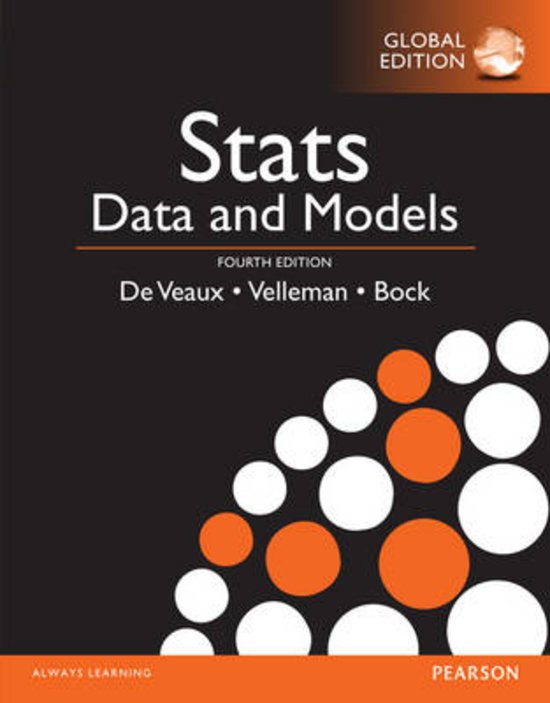Premaster Business Administration 1B
Inferential Statistics
By Easysummary for Stuvia
,Table of contents
Lecture 1 & 2 Inference for proportions 3
Lecture 3 Hypothesis testing for proportions 4
Lecture 4a Inference for means 5
Lecture 4b more about tests 6
Lecture 5 Inference for two and more means 7
Lecture 6a Inference about related means 8
Lecture 6b Inference about more means 9
Lecture 7 Association correlation and regression 10
Lecture 8 Association correlation and regression 11
Lecture 9 and 10 13
Lecture 11 Goodness-of-fit 14
Lecture 12 Inference about contingency tables 15
Easysummary 2
, Lecture 1 & 2 Inference for proportions
(and 2) (chapter 17.1, 17.2 and 18)
What is statistical inference and what is the difference between a parameter and a statistic?
Statistical inference draws conclusions about populations from data collected from a sample. A parameter
is about the population and a statistic about the sample.
What is a sampling distribution model, and what are the assumptions for using this model?
A sampling distribution model is a simulation of what we’d get if we could see all the proportions from all
possible samples. My model for 𝑝̂ is N(μ𝑝̂ , σ𝑝̂ ). Two assumptions via five conditions: The Independence
Assumption, The Sample Size Assumption, The Randomization Condition, The 10% Condition and The
Success/Failure Condition. Sample proportion 𝑝̂ is the total of successes divided by the total sample. The
outcome of this is the mean (at 𝑝̂ ).
Sampling distribution model for a proportion: SD(𝑝̂ ) = √(pq/n)
Sampling distribution of the mean: SD(𝑦
̅) = σ
√n
What is a standard error? (related to sampling distribution models)
Standard error is estimating the standard deviation (the amount of variation in the sample proportion we
expect to see from sample to sample in a particular case) of a sampling distribution by 𝑝̂ and not p,
because we don’t have p. So instead of SD (𝑝̂ ) = √(pq/n), we now use SE (𝑝̂ ) = √(𝑝̂ 𝑞
̂ /n) (estimating the
standard deviation of a sampling distributing using statistics found from the data).
What is a point estimate and an interval estimate of a population parameter?
Point estimate is a single value, an interval estimate is defined by two numbers between which a
population parameter is said to lie.
What is a confidence interval for a population parameter and what is the margin of error?
Statements like “we are 95% confident that this interval contains the true proportion” are called confidence
intervals. The extend of the interval on either side of p is called the margin of error (ME). Calculation:
depending on the confidence level its 1, 2 or 3 SE’s. So calculate the SD x amount of SE’s.
What type of conclusion can we draw from a confidence interval?
Explain what your interval means: we are 95% confident, based on this sample, that the proportion of all
auto accidents that involve teenage drivers is between 12,2% and 18,2%.
Explain what 95% confidence means: about 95% of all random samples of this size will produce confidence
intervals that contain the true population proportion.
How can we construct a confidence interval to estimate a population proportion?
Margin of error (ME) = z* x SE(𝑝̂ ) and SE (𝑝̂ ) is √(pq/n) z*√(𝑝̂ 𝑞
̂/n) we are % confident that this
estimate is within % of the true proportion of [story]. To be more certain, we must be less precise.
Confidence interval: Estimate ± ME 𝑝̂ ± z*√(𝑝̂ 𝑞̂/n)
Critical value = z* (the number of SEs)
To get more confidence, we need to capture p more often and make the interval wider, for example with
99,7% its 3 SE. The more confident we want to be, the larger the margin of error must be.
How can we calculate the sample size for estimating a population proportion? (p. 498)
Given: within 3% with 95% confidence ME = z*√(pq/n) fill in so 0,03 = 1,96√(pq/n) use 0,5 for
both p and q so 0,03 = 1,96√(0,5x0,5/n) multiply by √n, so 0,03√n = 1,96√(0,5x0,5) divide by 0,03
so √n = 1,96√(0,5x0,5) =
0,03
Calculator: ((z*)2x(0,5)x(0,5)):(error margin)2
Easysummary 3






